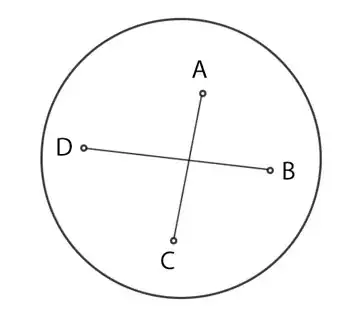I designed this problem and tried to solve it but didn't solve.
Choose four points $A$, $B$, $C$ and $D$ from inside of a circle uniformly and independent. What is the probability that $AC$ intersects $BD$?

I designed this problem and tried to solve it but didn't solve.
Choose four points $A$, $B$, $C$ and $D$ from inside of a circle uniformly and independent. What is the probability that $AC$ intersects $BD$?

There are 2 general cases here, either one point lies in the triangle formed by the other 3, or there is no such point. The diagram above is an example of the second case. In the first case, there is no way to connect the line points with 2 lines segments, such that the segments intersect. In the second case, it is possible, but only in the case where "opposite" points are chosen, which is 1 out of 3 possible. So, if the probability of having no point lie in the interior of the triangle formed by the other 3 is $P$, the probability is $\frac{1}{3}P$. Now the trick is how to find $P$.
[edit] As Jack notes below, this separate problem has been solved here, yielding $$P=1−\frac{35}{48 \pi^2}$$